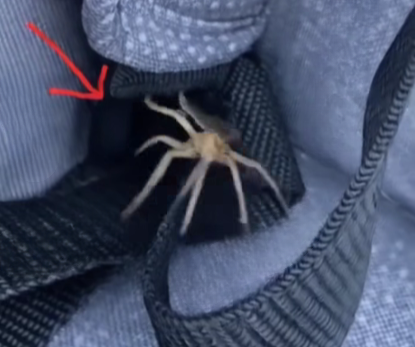Camel Spiders in Cars: Complete Guide to Identification and Removal

The Shocking Discovery That Changed My Daily Commute
Picture this: you’re settling into your car for another routine drive when something catches your eye. What appears to be an innocent piece of fabric lint suddenly moves across your seatbelt. That moment of realization – when harmless debris transforms into something alive – can turn an ordinary day into an unforgettable encounter with nature’s most misunderstood arachnids.
This comprehensive guide will cover everything you need to know about automotive pest control, specifically focusing on Solifugae encounters in vehicles. Whether you’re dealing with a current infestation or looking to prevent future problems, this expert advice will help you maintain a safe, comfortable driving environment.
Understanding Solifugae: The Facts Behind the Fear
Scientific Classification and Characteristics
Solifugae, commonly called camel spiders, sun spiders, or wind scorpions, represent a unique order within the arachnid family. These desert-dwelling creatures have evolved remarkable adaptations that make them both fascinating and formidable.
Key Physical Characteristics:
- Speed capabilities: Reaching speeds up to 10 mph, making them among the fastest terrestrial arachnids
- Size variations: Most species measure 1-3 inches, though some specimens can reach 6 inches including leg span
- Distinctive features: Prominent chelicerae (jaw structures) designed for efficient prey capture
- Habitat preferences: Arid and semi-arid environments across North America, particularly southwestern states
Important Safety Information
Unlike venomous spiders or scorpions, Solifugae lack venom glands entirely. However, their powerful mandibles can deliver painful bites that may result in:
- Immediate sharp pain and localized swelling
- Potential bacterial infections if wounds aren’t properly cleaned
- Temporary discomfort lasting several days
Why Your Vehicle Attracts These Arachnids
Environmental Factors
Modern vehicles create ideal microenvironments that appeal to desert-dwelling creatures seeking shelter. Understanding these attraction factors helps develop effective prevention strategies:
Primary Attractants:
- Temperature regulation: Cars retain heat after sunset, providing warmth during cooler desert nights
- Food sources: Crumbs and spilled beverages attract insects, which serve as prey for hunting arachnids
- Shelter opportunities: Dark crevices around upholstery, floor mats, and door seals offer perfect hiding spots
- Moisture retention: Higher humidity levels inside vehicles compared to external desert conditions
High-Risk Parking Locations
Certain environments significantly increase your chances of unwanted arachnid encounters:
- Desert camping areas and recreational vehicle parks
- Rural properties with native vegetation
- Construction sites in arid regions
- Outdoor storage facilities in southwestern states
Professional Identification Guide
Visual Recognition Signs
Early detection prevents larger infestations and reduces encounter risks. Watch for these indicators:
Movement Patterns:
- Extremely rapid, darting motions when disturbed
- Preference for shadowy areas and tight spaces
- Activity increases during twilight hours
Physical Evidence:
- Shed exoskeletons near floor mats or seat tracks
- Small prey remains (deceased insects) in vehicle corners
- Disturbed dust patterns in previously undisturbed areas
Comprehensive Removal Strategies
Immediate Response Protocol
When you discover these arachnids in your vehicle, follow this systematic approach:
Step 1: Safety Preparation
- Wear protective gloves and closed-toe shoes
- Ensure adequate lighting for thorough inspection
- Keep first aid supplies accessible
Step 2: Thorough Cleaning Process
- Use high-powered vacuum cleaners with crevice attachments
- Focus on seat tracks, door seals, and floor mat edges
- Clean cup holders, glove compartments, and storage areas
Step 3: Environmental Modification
- Remove all food sources and organic debris
- Increase ventilation to reduce moisture buildup
- Apply natural deterrents in strategic locations
Advanced Prevention Techniques
Automotive Maintenance Approaches:
- Seal integrity inspection: Regularly examine weather stripping and door seals for gaps
- Interior climate control: Use moisture-absorbing products to maintain dry conditions
- Parking strategy optimization: Choose concrete surfaces over natural ground when possible
Natural Deterrent Solutions:
- Essential oil treatments (peppermint, eucalyptus, citrus)
- Diatomaceous earth application around entry points
- Cedar-based repellent products for long-term protection
Professional Pest Management Options
When to Contact Experts
Consider professional intervention if you experience:
- Recurring sightings despite prevention efforts
- Multiple specimens discovered simultaneously
- Concerns about proper identification or safety procedures
Service Options:
- Mobile pest control specialists familiar with automotive treatments
- Integrated pest management programs for rural properties
- Educational consultations for high-risk area residents
Regional Risk Assessment
Geographic Distribution Patterns
Understanding regional prevalence helps travelers and residents prepare appropriately:
Highest Risk States:
- Arizona, Nevada, New Mexico, Texas, California
- Southern Colorado, Utah, and Oklahoma
- Northern Mexico border regions
Seasonal Activity Patterns:
- Peak activity: Late spring through early fall
- Reduced activity: Winter months in most regions
- Year-round presence: Southern desert areas
Long-Term Vehicle Protection
Maintenance Schedule Recommendations
Establish consistent routines to maintain arachnid-free vehicles:
Weekly Tasks:
- Comprehensive interior cleaning and vacuuming
- Food debris removal and surface sanitization
- Visual inspection of common hiding areas
Monthly Assessments:
- Weather stripping condition evaluation
- Natural repellent reapplication
- Deep cleaning of storage compartments
Seasonal Preparations:
- Pre-travel inspections for desert region visits
- Climate control system maintenance
- Professional pest prevention consultations
Emergency Response Guidelines
First Aid for Encounters
Should you experience a bite incident:
- Immediate care: Clean wound thoroughly with antiseptic solution
- Monitor symptoms: Watch for signs of infection or allergic reactions
- Medical consultation: Seek professional medical advice if symptoms persist
- Documentation: Photograph the specimen if safely possible for identification
Conclusion: Maintaining Peace of Mind
While discovering arachnids in your vehicle can be unsettling, understanding their behavior and implementing proper prevention strategies ensures safe, comfortable travels. These creatures play important ecological roles in their natural habitats and typically avoid human contact when possible.
Remember that effective automotive pest management combines regular maintenance, environmental awareness, and appropriate response protocols. By following these evidence-based recommendations, you can confidently navigate arid regions while maintaining a pest-free vehicle environment.
Whether you’re a desert resident, outdoor enthusiast, or occasional traveler through southwestern landscapes, this knowledge empowers you to handle unexpected encounters with confidence and maintain optimal vehicle conditions year-round.